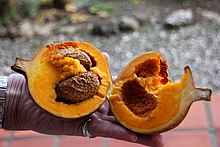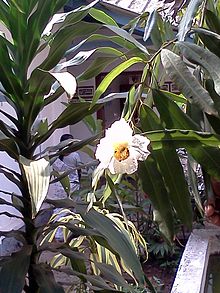Calophyllaceae
| Calophyllaceae | ||||||||||||
|---|---|---|---|---|---|---|---|---|---|---|---|---|

|
||||||||||||
| Systematics | ||||||||||||
|
||||||||||||
| Scientific name | ||||||||||||
| Calophyllaceae | ||||||||||||
| J. Agardh |
The Calophyllaceae are a family in the order of the Malpighiales (Malpighiales) within the flowering plants . It is a pantropical family with 14 genera and around 476 species. Some species provide wood and a few species eat the fruit.
description
Vegetative characteristics

They usually grow as trees or, less often, bushes . Some types contain colored milky sap . Essential oils contain many types. There are schizogene channels or containers. Significant bleeding is often seen when branches are cut.
The leaves are alternate and spiral or two rows to opposite arranged on the branches ( phyllotaxis ). The simple, mostly flat leaves often have translucent points or channels. The leaf margin is smooth. Stipules are missing.
Generative characteristics
The hermaphroditic, radial symmetry flowers are four or five-fold. Marila asymmetralis is the only species of the family that does not have radial symmetry flowers. The four or five sepals are free. The mostly four or five (zero to eight) free petals appear deformed in some species. There are usually many mostly free stamens that are not grouped in recognizable bundles. The anthers often have large, simple or complex glands. Usually two or five carpels have become a top permanent ovary grown. There are one to a few ovules in each ovary compartment . The mostly long stylus ends in a moist, spreading to punctiform scar without papillae .
There are stone fruit , berries or fruit capsules formed, which contain one to many seeds. The capsule fruits open along the septal radius; all the taxa with capsule fruits standing together in a clade all have alternate leaves. The seeds, which are very variable in size, consist almost entirely of the two often large cotyledons ( cotyledons ).




Systematics
The family name Calophyllaceae was published in 1858 by Jacob Georg Agardh in Theoria systematis plantarum , p. 121. The reactivated family of the Calophyllaceae includes all taxa that were finally classified in the subfamily Kielmeyeroideae within the family of the Clusiaceae . The Clusiaceae s. l. were polyphyletic with the Hypericaceae , which were also separated out .
- The family of the Calophyllaceae is divided into two tribes and contains about 14 genera with about 476 species:
- Tribe Calophylleae: With twelve genera:
-
Calophyllum
L .: With 180 to 200 evergreen tree species.
- Calophyllum inophyllum L .: East Africa to Malesia and Northern Australia
- Caraipa Aubl. : With about 28 species in tropical South America.
- Clusiella Planch. & Triana : With about nine species in the Neotropic .
- Haploclathra Benth. : With about three species that occur in Amazonia.
- Kayea Wall. : With only two, according to some authors 50 to 70 species.
- Kielmeyera Mart. & Zucc. : With about 16 to almost 60 species in South America.
- Mahurea Aubl. : With only two evergreen tree species in the Neotropic .
-
Mammea L. (Syn .: Ochrocarpos Noronha ex Thouars , Paramammea J.-F. Leroy ) (sometimes to the tribe Garcinieae of the Clusiaceae): With about 50 to 70 pantropically distributed species, some tropical species also with edible fruits. Including:
- Mummy apple ( Mammea americana L. )
- Marila Sw. : With about 20 species in the Neotropic.
- Mesua L. (Syn .: Vidalia Fern.-Vill. ): With about seven species in Indomalesia.
- Neotatea Maguire : With about four kinds in the Neotropis.
- Poeciloneuron Bedd. : With at most two species in India.
-
Calophyllum
L .: With 180 to 200 evergreen tree species.
- Tribe Endodesmieae: With two African, monotypical genera:
- Endodesmia Benth. : With the only kind:
-
Lebrunia Staner : With the only kind:
- Lebrunia bushaie Staner .
- Tribe Calophylleae: With twelve genera:
Within the order of the Malpighiales , the Calophyllaceae are most closely related to the sister families Hypericaceae and Podostemaceae and these three families together with the sister families Bonnetiaceae and Clusiaceae form a secured clade .
Excerpt from the Malpighiales cladogram according to Wurdack & Davis 2009:
|
|
other Malpighiales |
|||||||||||||||||||||||||||
|
|
||||||||||||||||||||||||||||
|
||||||||||||||||||||||||||||
|
|
swell
- The Calophyllaceae family on the AP website. (Section description and systematics)
- Kenneth J. Wurdack & Charles C. Davis: Malpighiales phylogenetics: Gaining ground on one of the most recalcitrant clades in the angiosperm tree of life , in American Journal of Botany , 2009, Volume 96, pp. 1551-1570: PDF-Online. (Section systematics)
- David John Mabberley: The Plant Book. A portable dictionary of the higher plants . Cambridge University Press 1987. ISBN 0-521-34060-8
Individual evidence
- ↑ PFStevens: A revision of the Old World species of Calophyllum (guttiferae) , J. Arnold Arboretum , 1980, 61: 117-699.

